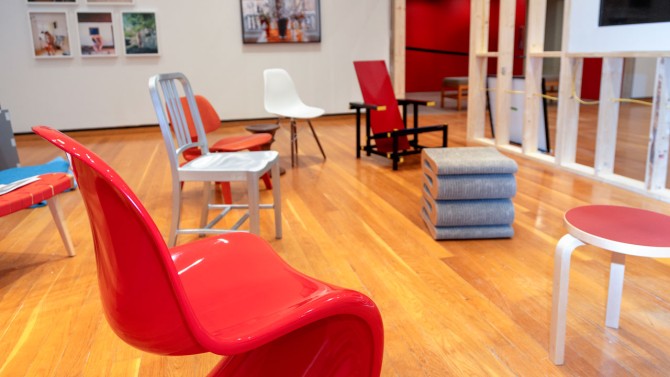
Museum staff members Annie Abernathy and Carin Wolfe install the exhibit “Home Making: Artists and the Domestic” at the Johnson Museum of Art.
Johnson Museum exhibit celebrates the art and science of the home
By Robin Roger
A bare wooden structure, evoking the frame of a home paused mid-construction, greets visitors in the Bartels Gallery of the Johnson Museum of Art.
The structure welcomes viewers to an exhibit on the myriad meanings of home, and invites them to interact with a historic collection of iconic interior design furnishings and the work of artists from Andy Warhol to Nan Goldin and more.
The exhibit, “Home Making: Artists and the Domestic,” opens on March 8 and will run through July 27. It celebrates a century of applying science and design to the study of the home, the result of a collaboration between the museum and the College of Human Ecology (CHE) as part of its centennial year.
“Seeing these collections together opens fresh ways of thinking about materiality, place and familial relationships,” says Annie Abernathy, the museum’s curatorial assistant and the lead coordinator for the show. “Visitors can see artworks with new perspectives alongside pieces from CHE’s Cornell Fashion + Textile Collection and iconic design chairs they can sit in and experience. Thanks to the creativity of both the CHE’s design team and the museum’s staff, the gallery becomes a kind of home itself, to experiment and ponder within.”
The exhibit explores how artists from the mid-1960s to the present have redefined and re-conceptualized the home. Beginning with the radical feminist interventions of Martha Rosler’s “Body Beautiful, Beauty Knows No Pain” photomontage series from 1966-72, the exhibition examines some of the many ways artists have interpreted the concept of “home.” From the anxious imagery of Goldin’s photography, to the joyful and biting photographic collections of Nona Faustine (“Princess and the Queen”) and Michael Jang (“At home with the Jangs”), “Home Making” suggests the modern home as a space of play and contemplation, of scientific inquiry and creative exploration, far more complex and boundless than the physical structure that contains it.
The show also features sculpture, video and other contemporary art from the Johnson’s permanent collection, as well as items from Cornell University Library’s Rare and Manuscript Collections.
“As the first of its kind collaboration between the Johnson Museum and the College of Human Ecology, this exhibit is a unique opportunity for the college to add to and bring visibility to its discourse in art, fashion and design,” said Eddy Man Kim, senior lecturer in CHE and director of its Digital Design and Fabrication Studio.
While the 1960s was a time of cultural revolution, it was also period of programmatic evolution for CHE. The college not only reorganized its departments and updated its curriculum; in 1969, it also changed its name from the College of Home Economics to the College of Human Ecology. The new name echoed the “ecological systems theory” developed by Urie Bronfenbrenner ’38, professor of human development and a member of the national Head Start Planning Committee, and highlighted the scientific rigor of the college.
A panel discussion about the exhibit on March 13, at 5:15 p.m. in the museum’s Robinson Lecture Hall, will include Michelle Grabner, a Wisconsin artist, writer and curator, and Danielle Dreilinger, a journalist and author of “The Secret History of Home Economics: How Trailblazing Women Harnessed the Power of Home and Changed the Way We Live.”
Both the exhibit and the panel discussion are free and open to the public.
Robin Roger is the assistant dean for communications for the College of Human Ecology.
Media Contact
Get Cornell news delivered right to your inbox.
Subscribe

